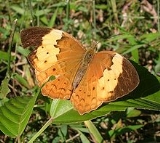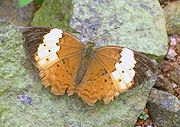
Cupha erymanthis
Encyclopedia

Species
In biology, a species is one of the basic units of biological classification and a taxonomic rank. A species is often defined as a group of organisms capable of interbreeding and producing fertile offspring. While in many cases this definition is adequate, more precise or differing measures are...
of brush-footed
Nymphalidae
The Nymphalidae is a family of about 5,000 species of butterflies which are distributed throughout most of the world. These are usually medium sized to large butterflies. Most species have a reduced pair of forelegs and many hold their colourful wings flat when resting. They are also called...
butterfly
Butterfly
A butterfly is a mainly day-flying insect of the order Lepidoptera, which includes the butterflies and moths. Like other holometabolous insects, the butterfly's life cycle consists of four parts: egg, larva, pupa and adult. Most species are diurnal. Butterflies have large, often brightly coloured...
found in forested areas of tropical South Asia
South Asia
South Asia, also known as Southern Asia, is the southern region of the Asian continent, which comprises the sub-Himalayan countries and, for some authorities , also includes the adjoining countries to the west and the east...
and Southeast Asia
Southeast Asia
Southeast Asia, South-East Asia, South East Asia or Southeastern Asia is a subregion of Asia, consisting of the countries that are geographically south of China, east of India, west of New Guinea and north of Australia. The region lies on the intersection of geological plates, with heavy seismic...
.
Description

Glossary of Lepidopteran terms
This glossary describes the terms used in the formal descriptions of insect species, jargon used mostly by professionals or entomologist....
, broadening posteriorly, the margins irregularly sinuous, the inner defined broadly with black, and produced outwards in interspaces 3 and 4, below this the margin is squarely indented inwards in interspace 2 and outwardly convex in interspace 1 ; a curved series of three black spots, the lowest the largest, in interspaces 1, 2 and 3; apical area beyond the band black, with a conspicuous yellow subapical spot in interspace 5, and a paler ill-defined similar spot above it in interspace 6; posteriorly the black area is produced narrowly to the tornus
Glossary of Lepidopteran terms
This glossary describes the terms used in the formal descriptions of insect species, jargon used mostly by professionals or entomologist....
and encircles a yellow spot near apex of interspace 2.
Hind wing: a transverse sinuous, very slender, black line, followed by a slender somewhat lunular line, a transverse discal series of five black spots in interspaces 2 to 6, a postdiscal medially disjointed series or broad black lunules, a subterminal series of similar but straighter lunules, and a narrow terminal black band. The outer subbasal transverse line broadens at the costa, and is outwardly margined by pale spots in the interspaces, these are anteriorly white, well defined, posteriorly obscure, often absent.
_in_talakona_forest,_ap_w_img_8267.jpg)
Fore wing : a discal, transverse, slender, chestnut-brown lunular line, bent inwards above vein 5, and bordered outwardly by a series of dark spots; the large black spot in interspace 1 as on the upperside, and an inner and an outer transverse subterminal series of small dentate spots.
Hind wing: some indistinct cellular markings; the outer subbasal dark transverse line as on the upperside but more clearly defined, very sinuous; a transverse discal series of uneven lunules, paler than the groundcolour, followed by a series of dark spots, a postdiscal very obscure pale lunular band, and a subterminal series of dentate dark spots, often obscure or obsolescent. Antennae, head, thorax and abdomen ochraceous brown; beneath, the palpi, thorax and abdomen very pale ochraceous white.
The caterpillar
Caterpillar
Caterpillars are the larval form of members of the order Lepidoptera . They are mostly herbivorous in food habit, although some species are insectivorous. Caterpillars are voracious feeders and many of them are considered to be pests in agriculture...
is brown, with a dorsal and a lateral series of darker brown markings; head with two slender branched spines, succeeding segments with on each side a lateral series of semitransparent similar brown spines. The pupa
Pupa
A pupa is the life stage of some insects undergoing transformation. The pupal stage is found only in holometabolous insects, those that undergo a complete metamorphosis, going through four life stages; embryo, larva, pupa and imago...
is green, studded with eight slender pink filaments and four small pink tubercles.
Subspecies and variants
Var. nicobarica Felder: generally but not always, has the interspace between the postdiscal and subterminal transverse series of lunules on the upperside of the hind wing paler than the groundcolour of the wings.Subspecies
Subspecies
Subspecies in biological classification, is either a taxonomic rank subordinate to species, ora taxonomic unit in that rank . A subspecies cannot be recognized in isolation: a species will either be recognized as having no subspecies at all or two or more, never just one...
andamanica Moore: Upperside ground-colour very dark ochraceous brown, much darker than in erymanthis generally ; markings on both upper and under sides similar, but on the upper-side the spots on the discal band on the fore wing larger, especially the lowest spot; on the hind wing the upper three spots of the discal series conspicuously larger; on the underside the groundcolour is darker and the markings more clearly defined than in the typical form.
_in_talakona_forest,_ap_w_img_8212.jpg)
Ecology
Caterpillars feed mainly on FlacourtiaceaeFlacourtiaceae
Flacourtiaceae is a defunct family of flowering plants whose former members have been scattered to various other families, mostly to Achariaceae, Samydaceae, and Salicaceae. It was so vaguely defined that hardly anything seemed out of place there and it became a dumping ground for odd and anomalous...
species, e.g. Flacourtia montana, F. ramontchii, F. rukam, Xylosma racemosa and Scolopia
Scolopia
Scolopia is a genus of plants in family Salicaceae.Notable species are:* Scolopia oreophila Killick* Scolopia braunii & Sleumer - an Australian rainforest tree* Scolopia mundii Warb...
spp.. they also eat plants like Glochidion eriocarpum and Lepisanthes rubiginosum.
Adult butterflies occasionally visit carrion
Carrion
Carrion refers to the carcass of a dead animal. Carrion is an important food source for large carnivores and omnivores in most ecosystems. Examples of carrion-eaters include vultures, hawks, eagles, hyenas, Virginia Opossum, Tasmanian Devils, coyotes, Komodo dragons, and burying beetles...
to drink liquids. They seem to favor carcasses lying in exposed, sunny areas over those which are in the shade.

